July 20 update on COVID-19 in MN: 9-month-old dies; record spike in new case counts
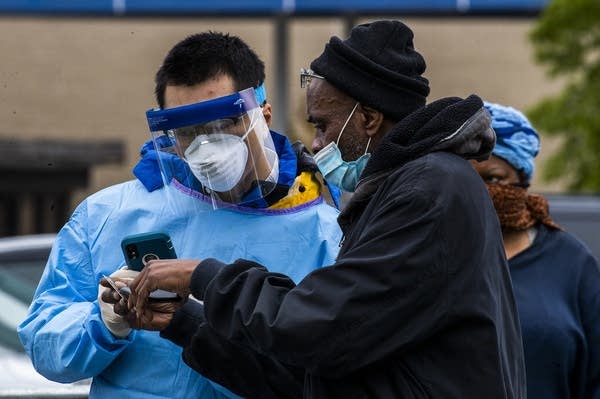
Updated: 6:50 p.m.
Minnesota’s COVID-19 toll continued to climb Monday with 922 new cases and an extra measure of heartbreak — the first death of a child in the state, a 9-month-old in Clay County, home to Moorhead.
The infant is among the youngest deaths in the country from COVID-19 and the first death in Minnesota for anyone under age 20 who tested positive for COVID-19. The child did not have an underlying health problem and had not been hospitalized, Kris Ehresmann, the state’s infectious disease director, told reporters.
The infant tested positive for COVID-19 and was identified as having an upper and lower respiratory infection; both were counted as causes of death, she said.
“A death involving such a young person is tragic, and certainly very unusual,” said Health Commissioner Jan Malcolm, adding that the state has asked the federal Centers for Disease Control and Prevention to investigate.
Create a More Connected Minnesota
MPR News is your trusted resource for the news you need. With your support, MPR News brings accessible, courageous journalism and authentic conversation to everyone - free of paywalls and barriers. Your gift makes a difference.
Ehresmann said while current knowledge of the coronavirus puts children at lower risk, the possibility of infection is still there and officials are hoping to understand more about how the virus can affect children.
“In general, we have seen fewer cases in kids, we’ve seen fewer cases with hospitalizations and fewer cases with the need for intensive care,” she said, “but what we don’t know — and I think this is true for all ages — we don’t really know the underlying long-term impacts of a COVID infection on an individual.”
Ehresmann added the spread of coronavirus to children is less likely to happen from another child and more likely to come from an adult to children, like in a household setting.
Cases jump, hospitalizations dip
Patterns in Monday’s data continued to reflect what’s been happening for three weeks now — new case counts leaping as deaths and hospitalizations flatten.
The Health Department reported four more deaths, bringing the total to 1,545 since the pandemic began. Total current hospitalizations (247) and those needing intensive care (115) continue to dip.
Officials, however, have been bracing Minnesotans to expect those numbers to rise as cases continue to jump.
The 922 infections posted Monday were a record for daily confirmed cases, although officials said the high number comes partly from the fact they are transitioning to a new reporting system, which may make the daily numbers choppy over the next few days.
While people in long-term care continue to account for nearly 80 percent of the deaths from COVID-19, Monday was the first time the state recorded no deaths in long term-care since it started providing such demographic data in early May.
Of Minnesota’s 47,107 confirmed cases since the pandemic began, about 86 percent of those infected have recovered to the point they no longer need to be isolated.
Cases growing in most age brackets
State health officials continue to worry about the recent spike of coronavirus cases in younger Minnesotans, including that those infected will inadvertently spread the virus to more vulnerable populations.
Minnesotans in their 20s now make up the age group with the most confirmed cases with nearly 11,000. The median age of Minnesotans infected has been trending down in recent weeks and is now 37 years old.
Health investigators, however, are starting to see more cases in many age brackets, including ages 30 through 59, as more people get together for family gatherings and summer fun without social distancing, Ehresmann said.
It’s not like the situation the past few weeks where 20-somethings meeting in bars drove the increases. Now, analysts are seeing an evolution in the “larger, gradual increase in social activities,” she added.
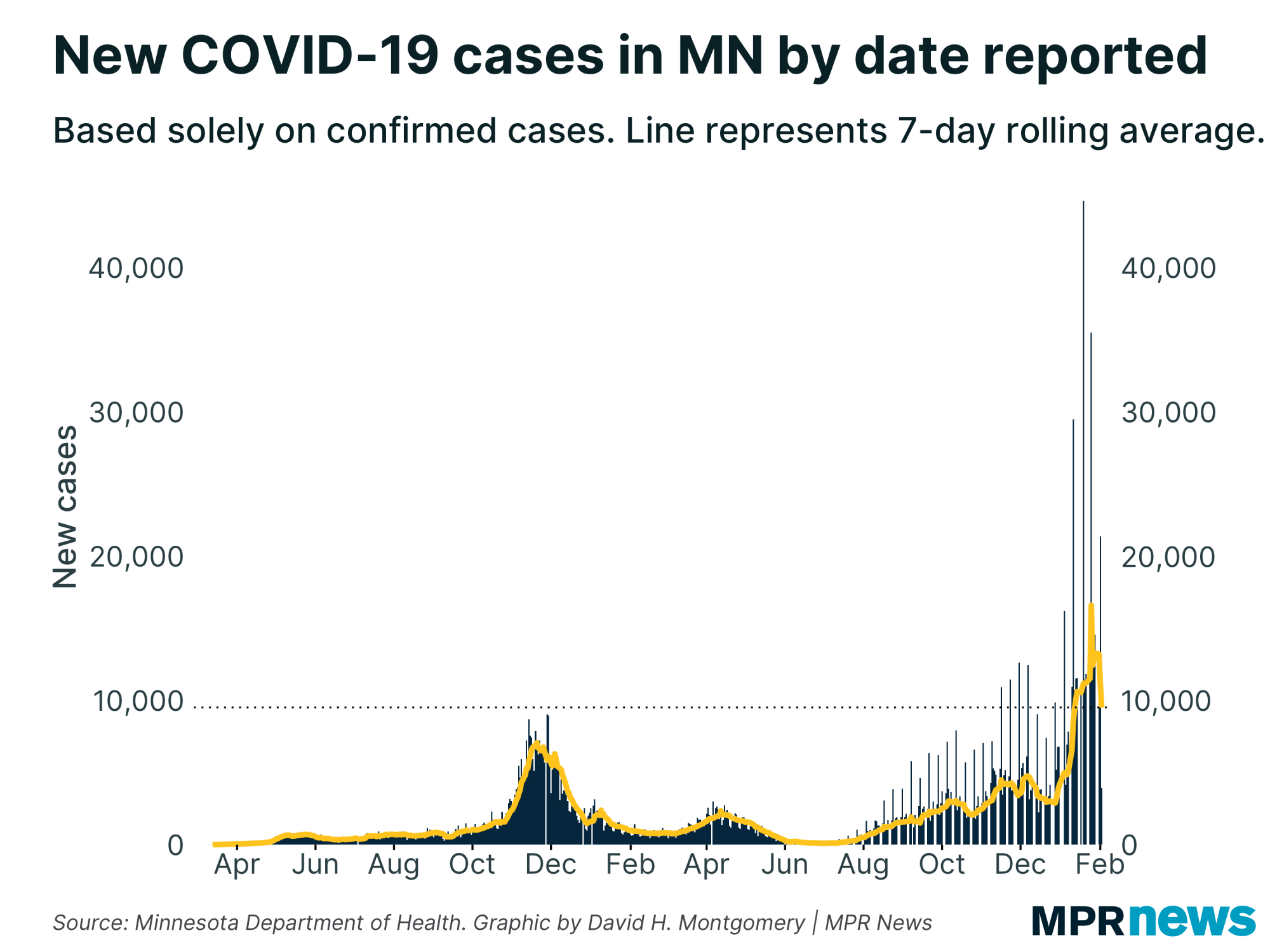
While current hospitalization counts in Minnesota remain relatively low, Ehresmann reiterated that officials expect the numbers to go on the march as the new cases climb.
New cases are also rising in northern Minnesota. Cases in Beltrami County have nearly doubled in the past week, from 53 to 101. Ehresmann on Monday said the case increase is tied to spread from a “number of events” including athletic events.
Not playing ‘gotcha’
The latest counts come as officials try to get their arms around clusters of problems centered around bars and restaurants.
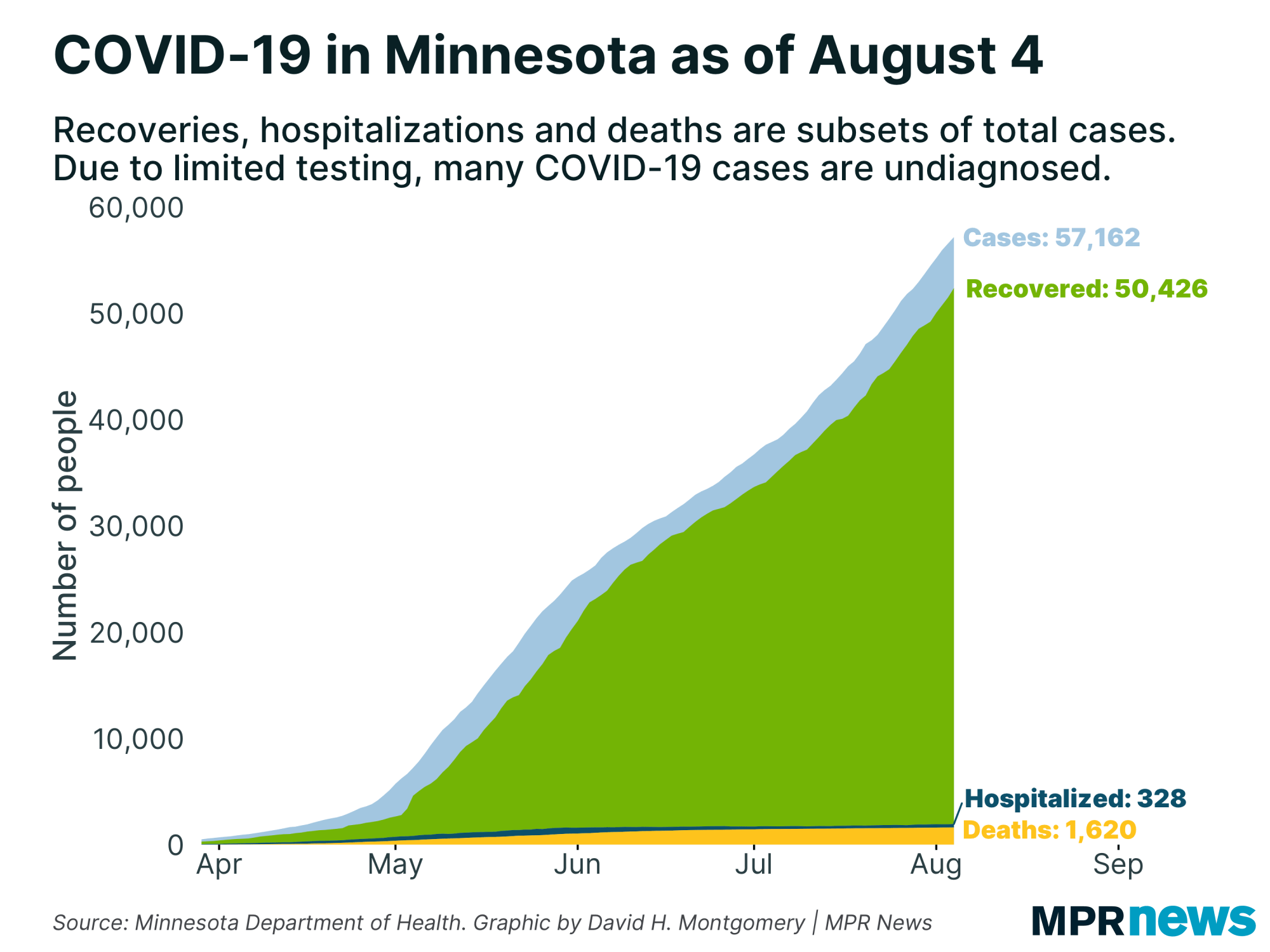
State investigators say they’ve received some 120 complaints recently from concerned residents reporting violations of the current orders around gathering in indoor social spaces, particularly bars and restaurants, Malcolm said Friday.
Complaints include staff not wearing masks, not enough social distancing and too many people at a site.
Because of that, the state is “stepping up enforcement,” Malcolm said, “not to play gotcha with restaurants and bars but because we feel it’s so essential” to protect Minnesotans.
Malcolm said most bar and restaurant owners who’ve been flagged have responded positively. She also noted that establishments that don’t comply are subject to cease-and-desist orders.
Malcolm said health officials continue to hope that bars, restaurants and other indoor social spaces get the message. The state, she said, is working to avoid “wholesale closure” of these places but that the rise in community spread must be checked.
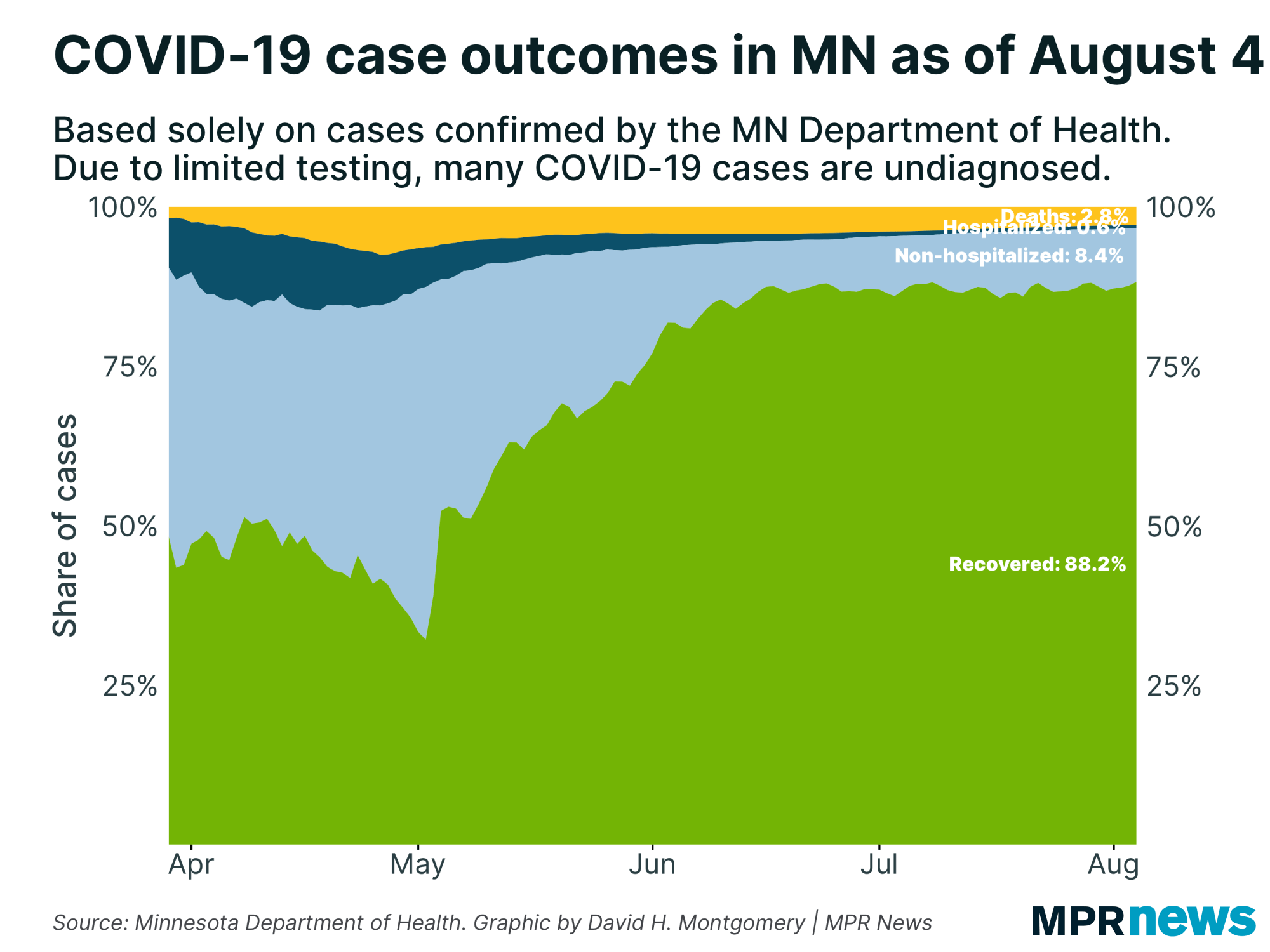
“But in all candor, I don't think anything can be considered completely off the table with what we're seeing around the country and in our own numbers in Minnesota,” she added. “But we clearly would like to explore intermediate measures before that.”
Walz weighing statewide mask order
The state's top public health leaders on Monday reiterated their support for a statewide mask mandate, saying such mandates have proven to help prevent transmission of COVID-19.
Several Minnesota cities already have mask requirements in place. As for a statewide mask mandate, DFL Gov. Tim Walz is weighing the measure, but has yet to enact one — despite pleas from medical groups and the state Health Department.
Walz recently expressed concern that Minnesotans were lagging on their mask-wearing. But Republicans, including Senate Majority Leader Paul Gazelka, R-East Gull Lake, have said a statewide mandate would be a mistake.
On Friday morning, Walz told MPR News that he believes a mask mandate is the right thing to do to slow the spread of the coronavirus but that he hasn't yet made a decision on whether to issue a statewide order.
"I'm trying to get them to buy in,” Walz said of Gazelka and others who oppose a statewide mandate. “It's unfortunate that around masks, it became somewhat of a political statement rather than a public health statement.”
More than half of U.S. states now require the use of masks or face coverings in public settings.
Meatpacking hot spots remain
Many of the outbreaks outside the Twin Cities metro area are focused around meatpacking plants. Officials have intensified testing in those hot spots, uncovering more infections.
That includes Mower County in southeastern Minnesota, where there were 1,008 confirmed cases as of Monday. Mower County is home to Hormel Foods and Quality Pork Processors. Both have been partnering with Mayo Clinic to ramp up employee testing.
While some of Mower County’s positive cases are associated with people who work in the facilities and with the people they live with, county officials say they are also seeing transmission among people who live in the county but work in other counties where coronavirus is present.
Nobles, in southwestern Minnesota, reported 1,706 confirmed cases as of Monday, with six deaths. About 1 in 13 people now have tested positive for COVID-19 in the county since the pandemic began, although the count of new cases has slowed considerably in recent weeks.
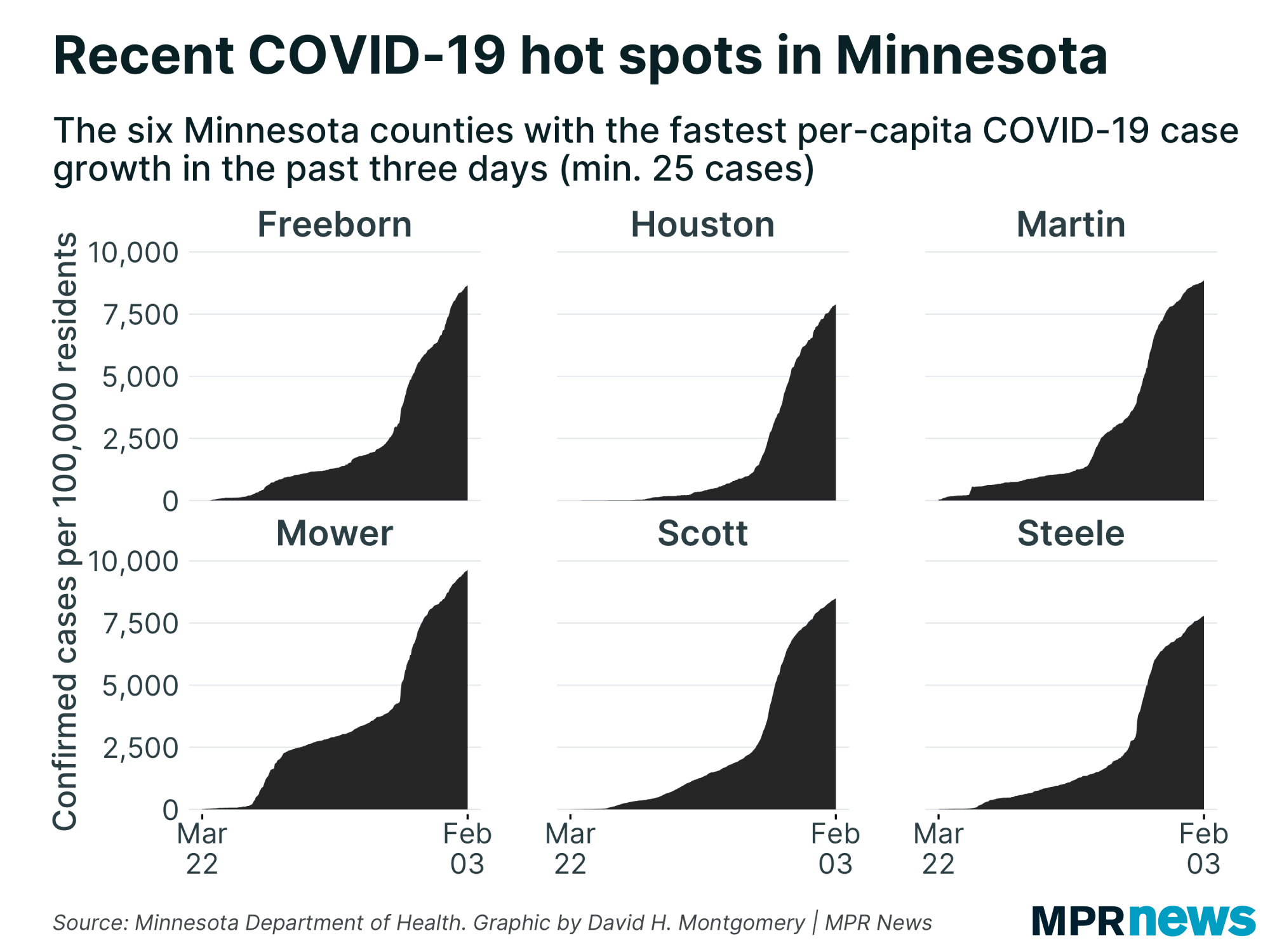
Worthington’s massive JBS pork processing plant was the epicenter of the Nobles outbreak. The JBS plant shut on April 20 but has since reopened with expanded hygiene and health monitoring measures.
Similar problems have been reported in Stearns County, where COVID-19 cases tied to two packing plants — Pilgrim’s Pride poultry plant in Cold Spring and Jennie-O Turkey in Melrose — skyrocketed in May. An undisclosed number of workers at both plants have tested positive for the virus.
There were about 55 confirmed cases in Stearns County in early May. By Monday, confirmed cases were at 2,643 with 19 deaths.
Kandiyohi County in west-central Minnesota is also dealing with a significant caseload more than two months after officials with the Jennie-O turkey processing plant there said some employees had tested positive for the coronavirus.
As of Monday, the Health Department reported 613 people have now tested positive. The county had confirmed three COVID-19 cases in late April.
Cases have also climbed noticeably in Lyon County (378 cases) around a turkey processor in Marshall.
Developments from around the state
MSP airport to require travelers wear a mask
The Minneapolis-St. Paul International Airport will be instituting a mask requirement next Monday.
The Metropolitan Airports Commission voted Monday to institute the mandate, although many airlines, businesses and other airports already require face coverings.
The new regulation applies in all public spaces at the airport, as well as any outdoor spaces that can’t accommodate social distancing. The face covering regulation applies in parking ramps, shuttle buses, trams and rental car operations.
The Twin Cities airport says information kiosks in the terminals will provide face coverings for people who don’t have them.
— Tim Nelson | MPR News
Klobuchar, health officials call for more plasma donations
U.S. Sen. Amy Klobuchar and Minnesota health officials are calling on the federal government to launch a nationwide effort to recruit plasma donors among people who have recovered from COVID-19.
Klobuchar, D-Minn., spoke at M Health Fairview in Minneapolis on Sunday.
COVID-19 survivors may have antibodies that can be key protections for people seriously ill with coronavirus infections. And while donations of the plasma that carries those antibodies initially proved relatively strong, the stocks have been diminishing.
Klobuchar said Minnesota has led the way — her own husband donated plasma at Mayo Clinic after being seriously ill with COVID-19.
"But a lot of places around the country that have even higher levels of COVID than we do here in Minnesota, just aren’t attuned to the need to give plasma. So that’s why we want to bring this out on a national basis," she said.
Dr. Claudia Cohn, associate director of laboratories and director of the blood bank laboratory at M Health Fairview, said places like New York have barely 10 percent of the plasma from recovered patients that they once had.
And while she says research is still figuring out the use of plasma as a treatment, donations from recovered COVID-19 patients are likely one of the fastest and beneficial options available to help people recover from coronavirus infections.
"Call Memorial Blood Centers, go online. Call the American Red Cross. Make an appointment to go donate your convalescent plasma. It takes less than two hours, usually about 90 minutes," she said. "And a single donation usually allows you to donate three units of convalescent plasma. That’s three lives you’ve potentially saved."
Klobuchar said she’s working with Republican Sen. Roger Wicker of Mississippi to get federal government support for the plasma donation campaign.
— Tim Nelson | MPR News
Teens press Minnesota lawmakers on jobless aid
High school-aged students shut out of work due to the pandemic are pleading with Minnesota lawmakers to make them eligible for unemployment aid.
State law prevents the students 16 and older from collecting benefits.
Cole Stevens of the youth-led Don’t Forget US Campaign told a House committee Friday that he was laid off from his food service job due to COVID-19 closures. He contributes to household bills.
Stevens, 18, of Bloomington, said he received some jobless aid but that was later retracted when the state determined him to be ineligible. When working, he uses his earnings to contribute to household bills.
“I’m not just some lazy teenager trying to maximize his welfare here,” Stevens said. “I needed that money back then when I was in high school and I wasn’t able to get it.”
A bill pending in the Legislature’s special session would allow student workers to qualify for benefits. The proposal would be only a temporary fix that covers March through December of this year.
The House Jobs and Economic Development Finance Committee advanced the bill on a 9-6 vote. The Minnesota Department of Employment and Economic Development, which administers unemployment benefits, supports the change.
DEED Commissioner Steve Grove urged lawmakers to revise a law dating to the 1930s that prevents young workers from qualifying for unemployment.
“If you’re old enough to work, you should be old enough to get unemployment benefits when you can’t work,” Grove said.
Grove said Minnesota is “way behind” many other states have already adjusted their laws to account for displaced young workers.
“These aren’t just aren’t kids with summer jobs for fun. For many of these students these unemployment benefits are primary or at least secondary breadwinners for their family,” Grove said. “That money is going into food on the table, clothes on their backs, keeping those families sustained throughout really challenging times. And when they can’t work, it is all that more challenging.”
Competing House and Senate proposals differ over whether the money would come from a federal relief program or the standard unemployment fund.
— Brian Bakst | MPR News
Top headlines
Masks now required in St. Cloud's indoor public space: The St. Cloud City Council Monday night became the latest Minnesota city to require masks in indoor public places. After a lengthy debate, the City Council voted 5 to 2 to approve the emergency ordinance, which takes effect immediately.
Some Minnesota employers happy to see extra jobless benefits end: Enhanced unemployment benefits to help offset the economic blow from the COVID-19 pandemic expire at the end of the week if Congress doesn't act. Some employers think those increased benefits have kept people from returning to the workforce.
COVID-19 in Minnesota
Data in these graphs are based off Minnesota Department of Health cumulative totals released at 11 a.m. daily. You can find more detailed statistics on COVID-19 at the Health Department website.
The coronavirus is transmitted through respiratory droplets, coughs and sneezes, similar to the way the flu can spread.
Correction (July 20, 2020): Dr. Claudia Cohn’s name was misspelled in an earlier version of this story.